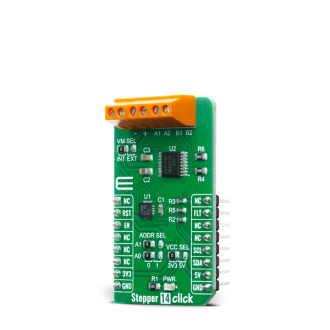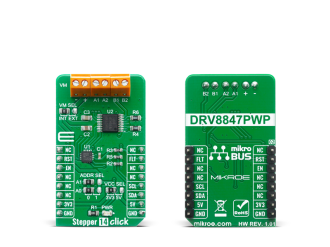
We strongly encourage users to use Package manager for sharing their code on Libstock website, because it boosts your efficiency and leaves the end user with no room for error. [more info]

Rating:
Author: MIKROE
Last Updated: 2020-07-01
Package Version: 1.0.0.0
mikroSDK Library: 1.0.0.0
Category: Stepper
Downloaded: 4033 times
Not followed.
License: MIT license
The Stepper 14 Click is a Click board that features the DRV8847PWPR, a step motor driver, from Texas Instruments. This Click boardâ„¢ provides a bipolar step motor controle, It features an H-bridge bipolar step motor driver, which supports full-, half-, quarter-, or eighth-step modes.
Do you want to subscribe in order to receive notifications regarding "Stepper 14 Click" changes.
Do you want to unsubscribe in order to stop receiving notifications regarding "Stepper 14 Click" changes.
Do you want to report abuse regarding "Stepper 14 Click".


Library Description
The library covers all the necessary functions that enables the usage of the Stepper 14 Click board. It initializes and defines the I2C driver and drivers that allow full control of the device to the user. User can use the device to control forward and reverse motion, apply brake and coast functions for brushless dc motors, and forward and reverse motion in full step and half step for stepper motors.
Key functions:
void stepper14_step_motor ( uint8_t interface, uint8_t direction, uint32_t steps_no ); - Function is used to drive two or four wire stepper motor in user defined direction, one step at a time.void stepper14_set_half_step ( uint8_t hl_step ); - Function is used to set specific half step.void stepper14_control_mode_set ( uint8_t mode ); - Function is used to set mode of operation.Examples description
The application is composed of three sections :
void application_task ( )
{
mikrobus_logWrite( " Stepper motor makes one turn forward ", _LOG_LINE );
stepper14_step_motor( STEPPER14_4_PIN_INTERFACE, STEPPER14_DIR_CW, 200 );
Delay_ms( 1000 );
mikrobus_logWrite( " Stepper motor makes one turn backward ", _LOG_LINE );
stepper14_step_motor( STEPPER14_4_PIN_INTERFACE, STEPPER14_DIR_CCW, 200 );
Delay_ms( 1000 );
}
Other mikroE Libraries used in the example:
Additional notes and informations
Depending on the development board you are using, you may need USB UART click, USB UART 2 click or RS232 click to connect to your PC, for development systems with no UART to USB interface available on the board. The terminal available in all MikroElektronika compilers, or any other terminal application of your choice, can be used to read the message.